This was published 1 year ago
Galapagos by custom-made yacht: Sailing the world's most remarkable volcanic 'hot spot'
By Kate Armstrong
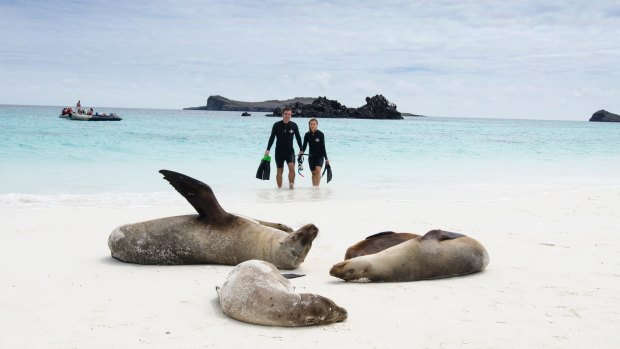
Celebrity Flora's Galapagos cruise includes daily activities like snorkelling, kayaking and tender rides.
"This evening we'll cross the Equator. Expect to feel a bump," jokes Marvi Cardova, Celebrity Flora's cruise director, as he runs through daily activities – snorkelling, kayaking, walking and tender rides – offered on our cruise in Galapagos. No thump ensues, and we sleep soundly in our stateroom, one of 50 spacious and luxurious cabins.
On embarking, Marvi had also requested that for simplicity, we keep our clocks on Quito time, one hour ahead of Galapagos, where we'd spent our first day exploring the city's fascinating historic centre.
The irony of "holding" time isn't lost on me. Especially given that we're in the epicentre of evolution, as posited by Charles Darwin following his five-week voyage aboard HMS Beagle in 1835 to four of the volcanic archipelago's 19 islands and many islets.
And during Celebrity Flora's week-long cruise around the "inner loop" of islands – Baltra, Santiago, Rabida, Isabela, Bartolome, North Seymour, San Cristobal and Santa Cruz – the ghost of Darwin keeps breathing down my neck.
Galapagos, the world's remarkable volcanic "hot spot", was declared a National Park in 1959. This means that around 95 per cent of the Galapagos is protected, with three per cent set aside for its 30,000 inhabitants.
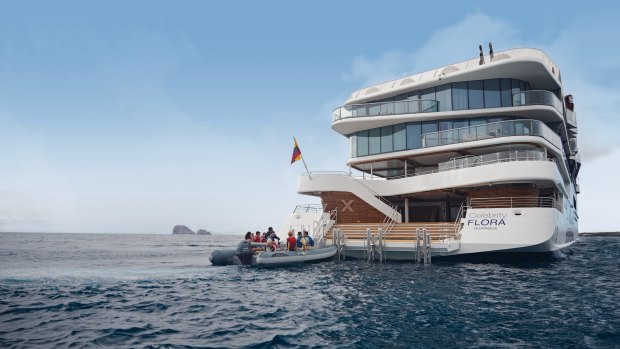
And Celebrity Flora adheres to strict environmental and social policies; it was, after all, custom built to cruise here.
Disposable plastic? None. Water? Desalinated water that's literally "on tap" in all rooms. Wastewater is treated in an uber-advanced way before it's released. The ship's "dynamic positioning system" removes the need to cast an anchor into the seabed and the engine thrusters are encased in rubber to lessen the noise impact on marine animals.
All balcony lights must be turned off at night so as not to disorient birdlife. A team of ten National Park certified naturalists is on board. It's an impressive start.
But visitors to Galapagos will always have an impact, and I'm not kidding myself otherwise. The onus to protect this fragile environment is also on us, Celebrity's 100 passengers and all privileged visitors – around 271,000 in 2018 (pre COVID-19) – who arrive by cruise boats or independently.
DAY ONE TWITCHING ON THE SANTIAGO AND RABIDA ISLANDS
Egas Port on Santiago Island sees our first landing, and a watery one at that; the "wet shoes" I've invested in – thanks to Celebrity's handy packing list – are submerged after I step off the tender's hydraulic ramp.
Ecstatic to be both in Galapagos and on this remote and pristine beach, I plonk down hurriedly on the sand to change my shoes. I'm of no interest to a sea lion that is resting just beyond; animals here are unfazed by humans.
The group follows guide Diego along a dirt trail, inland from the basalt cliffs. We're exposed to more birds than itemised on an ornithologist's checklist: Galapagos dove; Galapagos brown pelicans; yellow warbler... "Ooh!" I exclaim on glimpsing my first Galapagos finch, one of 13 surviving finch species that influenced Darwin's theories of natural selection (their different beaks evolved to adapt to different conditions and food varieties). And there's plenty of "oohs"; "firsts" are a thing here — a Santiago lava lizard, a Galapagos fur seal.
According to the US-based Galapagos Conservancy, endemic species here comprise around 80 per cent of land birds, 97 per cent of reptiles and land mammals, and more than 30 per cent of the plants. It's mind boggling.
We pause under an enclave of prickly pear, one of three endemic cacti. Eventually, I make out the form of a land iguana, a prehistoric reptile with a yellowish head. It moves in slow motion as though a remote-controlled robot on a Jurassic Park movie set. Cue a burst of camera beeps. Diego refocuses us: "Some of these cacti were around when Darwin was here."
That afternoon, we hit Rabida Island where the showstoppers are dark red oxidised sand and flamingos that are back nesting here after a 40 year absence due to introduced predatory species.
We wander over a rocky rise to a small lake where flamingos – their bright pink due to their diet of Artemia salina, a shrimp – are ankle deep in water, like tutu-wearing supermodels wading in a paddling pool for a fashion shoot. Others are atop large dirt mounds, nests it transpires, near the lake edge.
After each excursion, we disembark onto the ship's smart marina, a spacious, rear deck that is ground zero for all activities, where we're welcomed with a hot or cold towel and where we scrub our shoes so nothing is transmitted to another island.
Then we climb the stairs to be greeted by staff who, no matter whether it's morning or afternoon, offer us "snacks" of gourmet sandwiches and hot chocolates and exotic waters flavoured with fruit and cucumber. And we are a well fed lot.
The main dining room, Seaside Restaurant, is a welcoming area, with expansive windows and modern accents, from the artworks - on the few walls - to a contoured ceiling. Breakfast is a buffet (there's little you could want for) as is lunch; each day's culinary theme is a national cuisine.
It's the first day, but we are already aware of the effortless way Flora elevates our experience in these extraordinary surrounds; although she's tastefully decorated and extremely stylish, even down to the art and sculptures in the stairwells, she doesn't hog the limelight. Along with the professional crew, the ship is the perfect "vehicle" in every sense.
DAY TWO FLOATING BY ISABELA ISLAND
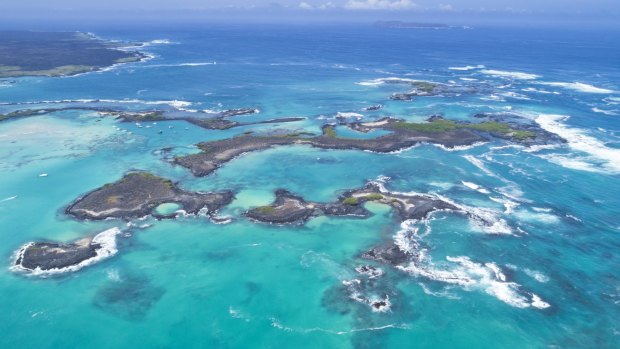
No walking is permitted at Elizabeth Bay on Isabela Island, a seahorse-shaped mass with six volcanoes and five caldera. Instead, we bounce along in a tender. I spy what I think are ducks. Ducks? I recalibrate' they're Galapagos penguins, the only penguins in the northern hemisphere. They bob and plunge and pop up again like corks. We laugh with excitement.
Our eureka moments resume. Perched on a black rock ledge are several Galapagos flightless cormorants, preening their stubby "once-were-wings". Bright red Sally Lightfoot crabs, oblivious to the fact that they're around one of the world's rarest birds, scuttle by. We could view this for hours but we're on a schedule, though the guides never let on.
The tender makes its way up a narrow channel that's enclosed by white mangroves. Tens of sea turtles appear, performing graceful figure eights, while a spotted eagle ray, identifiable for its vivid, white spots, glides ahead of the boat. The thrill of spotting new species, and being able to identify others, doesn't flag.
Back on ship we take stock. Each day, I vow to relax over a cocktail in the comfortable Discovery Lounge, a kind of "zone central", where guests gather regularly. Long sofas and wicker-style upright chairs are arranged around small tables, providing distinct and intimate spaces. Fabrics are in subtle greys with cream and teal cushions. The centrepiece is the massive and intensely bright screen that plays revolving scenes of locals plants and wildlife.
In one corner of the Lounge is the bar, a welcoming area that's framed by "Panama" hats (despite their accepted name, historically, these hats originate from Ecuador). I don't spend as much time here as I'd intended (with the exception of early mornings; Javier nails my coffee order) as FOMO ensures it never happens; I can't skip the activities, especially the deep water snorkelling.
In Tagus Cove, waters known for extensive marine species, we plunge off the side of the tender, enveloped in our wetsuits, with masks in place.
As we drift face down, parallel to the rocky cliff, I'm startled by a warped squeal; it's my partner transmitting a message through his snorkel. He points manically. A sea lion swoops underneath me. More pointing. To my right, a marine iguana ebbs and flows with the current, its jaw is clenched around rock-rooted algae.
I'm submerged in an aquatic-themed, technicoloured Disney animation: pink and grey Streamer hogfish; black-striped Salema; the comical dotted black Pacific burrfish. (I learn their names from the naturalists that make themselves available to guests at Flora's lab-cum-research centre).
Later, we slog to the island summit, Darwin's View, remarkable for its wide vista: a perfectly round lake (a former caldera) and four of the island's six volcanos. It dawns on me that, with the exception of Flora in the distance, Darwin surveyed the same scene.
DAY THREE OUTWARD FACING ON SANTIAGO AND BARTOLOME ISLANDS
By now, our routine alarm is a cup of tea, delivered to our suite at 6am by a friendly and efficient crew member (incredibly, there are 80 staff for the 100 passengers). Flora's stateroom configurations are exceptional: unlike other cruise ships, beds face outwards to the veranda and ocean so we survey daybreak through the full-length windows, marvelling at how the inky dark transforms into a soft illumination.
Then we rouse ourselves, first to shower in the spacious and light bathroom (cleverly, glass is the wall divider), then to enjoy 10 minutes on the veranda where, with our binoculars, we observe our Galapagos world as it enters the day: today, a pod of dolphins rises and falls past the ship (the binoculars are provided in your cupboard).
The sun is intense by the time we hit Sullivan Bay on Santiago Island. This basalt lava highway, an extraordinary carpet of black, red and brown textures, stretches as far as you can see.
The afternoon's walk takes us on a boardwalk over the barren, desert-like landscape of Bartolome, where we ascend 368 stairs. The view from the top, one of the most photographed in Galapagos, is indeed remarkable for the transition to greenery on a peninsula below; the first vibrant green we've seen on land.
Our evening meal is at the Ocean Grill, the outdoor casual dining area on Deck 7 that offers grilled seafood and meats. While we're munching on Galapagos tuna, a local fish and sustainably sourced, a wind sets in. Blankets appear from nowhere, courtesy of the staff.
Perhaps we've over-enjoyed our romantic setting, or consumed too much (very good) tempranillo, because on departing the restaurant we forget to head up one level to the stargazing observatory. Enthusiasts inform us that, away from the lights, this is a glorious spot to view the equatorial constellations.
DAY FOUR BROWN, RED AND BLUE ON NORTH SEYMOUR ISLAND
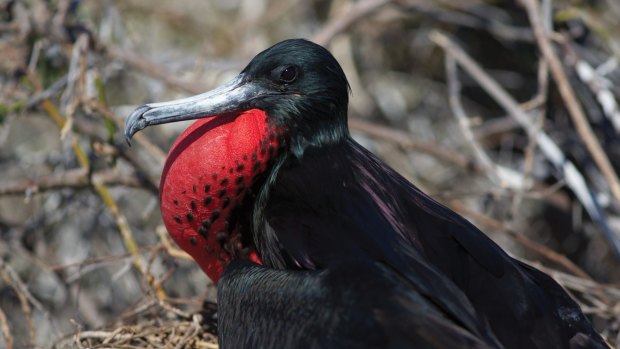
A brown gull greets us with a performance when we land on the dry, brown island of North Seymour. It stretches one leg out, and then the other. Guide Charly is in raptures. "It's a lava gull! One of the rarest gulls in the Galapagos. Only 400 pairs survive!" he says.
Surprisingly, my fellow passengers don't react. When I mention the group's indifference, Charly laughs: "Visitors want to see blue and red," he says, referring to the blue-footed boobies and the red-necked Frigates that are the "stars" here. Indeed, as if on cue, a blue-footed booby waddles up to a young passenger, seemingly attracted by his colourful hat (neutral colours are encouraged). I vow to appreciate the plainest of nature's gifts.
That said, I gasp when, a few metres on, several male frigates awkwardly balance on their nests of sticks. One inflates its red pouch at the base of its neck, trying to lure a female that flaps its wings above. We linger at nature's extraordinary show of "Goth-meets-punk-rockdom", but it's time to move on.
DAY FIVE KICKING IT ON KICKER ROCK AND SAN CRISTOBAL ISLANDS
Shards of sunrise break through the gap in Kicker Rock that we're navigating (in lieu of going ashore to Puerto Baquerizo Moreno, due to COVID-19 restrictions).
We've just devoured our freshly cooked omelettes (since day one, staff have nailed our preferences) when the captain announces "dolphins at starboard". We rush to the restaurant's massive windows and observe the dolphins rise and fall alongside the ship; there are few blind spots on Flora, glass affords onboard vistas from all areas.
An hour later, we wallow in the outdoor hot tub on The Vista, the ship's lovely sundeck where the many designer chairs and lounges are "dangerous": once you're settled, you don't want to leave. Especially the circular wicker daybed "cocoons" in which you can lounge and view the ship's wake. But for now, we have the deck to ourselves. My partner presses the tub's on-button, a giant manta ray catapults out of the ocean and smacks back down onto the glassy surface. We shriek with laughter at the coincidence.
The hike this day is on San Cristobal, a famous nesting place for all three species of boobies: blue-footed, Nazca, and red-footed. To date, the latter eludes us, though for red lovers, a glorious succulent, Galapagos carpet weed (Sesuvium edmonstonei) is spread along the cliff.
Bingo! Guide William signals to a spot below the track: scarlet feet and pale blue bill. A red-footed booby rests on a tree branch.
DAY SIX SLOWLY ON SANTA CRUZ ISLAND
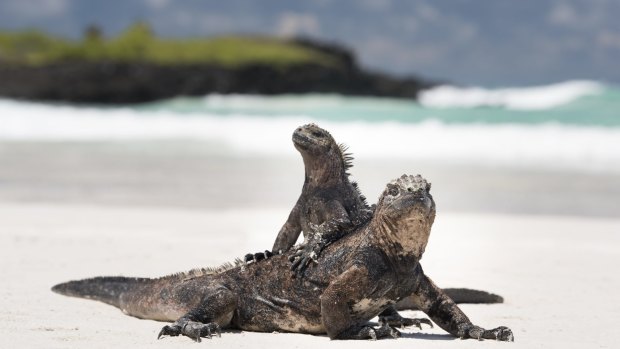
Passengers have eagerly anticipated this day, when we view domed and saddlebacked tortoises up close. At the Charles Darwin Research Centre, where tortoises are bred for repopulation, the facts come fast and thick: in the 1800s, whalers slaughtered over 200,000 tortoises for food and oil; Galapagos has 11 surviving tortoise species; they can move between 100 to 200 metres over land per day.
We're driven to a private property, Rancho Manzanillo, a rough clearing that's dotted with Cedrela, invasive Cuban cedar trees. "Humps" – Western Santa Cruz tortoises – punctuate the ground. We wander slowly, observing them munch on grass.
Their reptilian skin and sunken cheeks give the impression of doddery, elderly gentlemen; given that they live to well over 100 years, this might be the case. I feel privileged to be so close to them, yet somehow, I feel slightly uncomfortable encroaching on their turf.
After all, they can't run away, although one withdraws into its shell when a couple pose for a photo nearby. It's a telling response, perhaps.
On our return to the mainland for our final evening, we fly 1000 kilometres eastwards to Quito. The pilot announces the correct time, one hour forward. We don't need to adjust our watches, given our initial instructions.
But on flying over the city's sprawling cityscape to re-enter civilisation, I'm disoriented. I can't help feeling like we've jumped forward, or perhaps backward, a million years.
FIVE MORE EXPERIENCES ON AND OFF CELEBRITY FLORA
GLAMP
Given that you're in luxurious surrounds, it seems a little gimmicky to camp out on the top deck. But it's novel all the same. You nestle down for the night in a pod, to star gaze and be lulled by the ocean (or engine hum). To make it especially romantic, dinner is served in an adjoining pod.
LEARN
On-board naturalists give a daily talk on subjects such as "Charles Darwin's Life" and "Birds of the Galapagos" plus engineers and chefs explain the functioning of the ship. While always on duty, naturalists are available also in the laboratory ("Darwin's Cove") between 1pm and 2.30pm daily.
DINE
There are two dining options: Seaside Restaurant and the more casual, al fresco Ocean Grill. Both have various seat configurations and there are no assigned tables. The cuisine is exceptional; a daily themed buffet with produce, where possible, sourced from the islands..
EXPLORE
There's no pre-cruise excursion bookings. Instead, an evening briefing outlines the options for the next day (snorkel, walk, tender ride, kayak, or a combination), and you nominate your preference. Naturalists then arrange the groups around passenger demand, eliminating any angst about "missing out".
CROSS
One talk covers the traditions and history behind crossing the Equator and the importance of appeasing King Neptune. It's a tradition that Charles Darwin did not enjoy, given its water-based dunking rituals. No rough play takes place on Celebrity, though they gift a memorable souvenir (I won't spoil the surprise).
THE DETAILS
CRUISE
A 10-night experience in Quito and aboard Celebrity Flora is all inclusive: 2-nights pre-cruise luxury hotel; onboard staterooms with veranda; two dining options; beverages; wifi; and daily activities led by a naturalist team. Also provided is a range of amenities, from sunscreen to a recyclable drinking bottle. Fares from $13,100 a person.
BOOK
Phone 1800 003 002 or see celebritycruises.com
MORE
The writer was a guest of Celebrity Cruises.
Sign up for the Traveller Deals newsletter
Get exclusive travel deals delivered straight to your inbox. Sign up now.